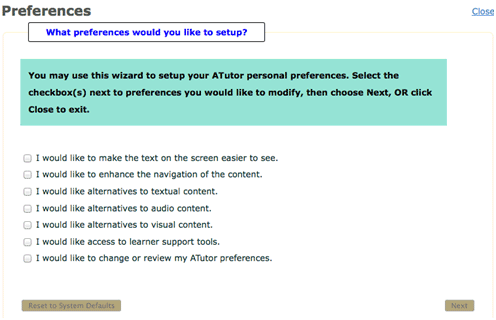
Such prompts encourage authors to add a text alternatives if they forget to include one when adding an image, for instance. ĪTutor includes a content authoring tool that prompts content developers to create accessible learning materials. These features also allow ATutor to adapt to a wide variety of technologies including cell phones, personal data assistants (PDAs), and text-based Web browsers, to name a few. With these features, a blind person can listen to the entire interface of the system with the help of a screen reader, and he or she can access the system without needing a mouse. Two, of many, accessibility features in the system are text alternatives for all visual elements, and keyboard access to all elements of the program. At the time a blind person for instance, could not participate fully in online courses. Results of the studies showed none of the popular Learning Management Systems at the time even provided minimal conformance with accessibility guidelines. It came in response to two studies conducted by the developer in the years prior that looked at the accessibility of online learning systems to people with disabilities. BackgroundĪTutor was first released in late 2002.


ATutor is also cited in numerous technical reviews and scholarly articles and many third-party extensions have been developed and distributed for use with the software. This aspect of ATutor has been affirmed in at least one University-published review of the software.
#ATUTOR REVIEWS SOFTWARE#
Its conformity with XHTML 1.0 is intended to ensure that ATutor is presented and displayed consistently in any compatible technology.ĪTutor's developers assert that it is the only fully accessible LCMS software on the market, including for-fee and closed source software. AccessibilityĪTutor is the first LCMS to comply completely with the accessibility specifications of W3C WCAG 1.0 at the AA+ level, allowing the access to all the included content of the system at all levels of user-privilege, including administrator accounts. ATutor is used internationally and has been translated into over fifteen languages with support for over forty additional language modules currently under development. The software is cited as unique for its accessibility features, (useful to visually impaired and disabled learners) and for its suitability for educational use according to software evaluation criteria established by The American Society for Training and Development (ASTD).
#ATUTOR REVIEWS PROFESSIONAL#
It also give some ideas to LMS developer in enhancing their LMS or proposing a new features.ATutor is used in various contexts, including online course management, continuing professional development for teachers, career development, and academic research. The findings from this review is quite interesting and it can be used to help users such as university/colleges, and students in selecting their LMS. The reasons are it consists of open source platforms such as Moodle, ATutor and Sakai and commercial platforms such as Blackboard and SumTotal.

To serve this purpose five learning management system are chosen which are Moodle, Sakai, SumTotal, Blackboard and ATutor among the other learning management systems in the market.

The purpose of this paper is to do systematic review on the current LMS, the problem with current LMS and the potential solutions that might help. The key criteria for analysing LMS are learning skills tools, productivity tools and communication tools. The LMS available usually offer similar features and is hard for user to choose which is appropriate for them. Currently, because of the Covid-19 pandemic there a lot of demand to use online Learning Management System (LMS).


 0 kommentar(er)
0 kommentar(er)
